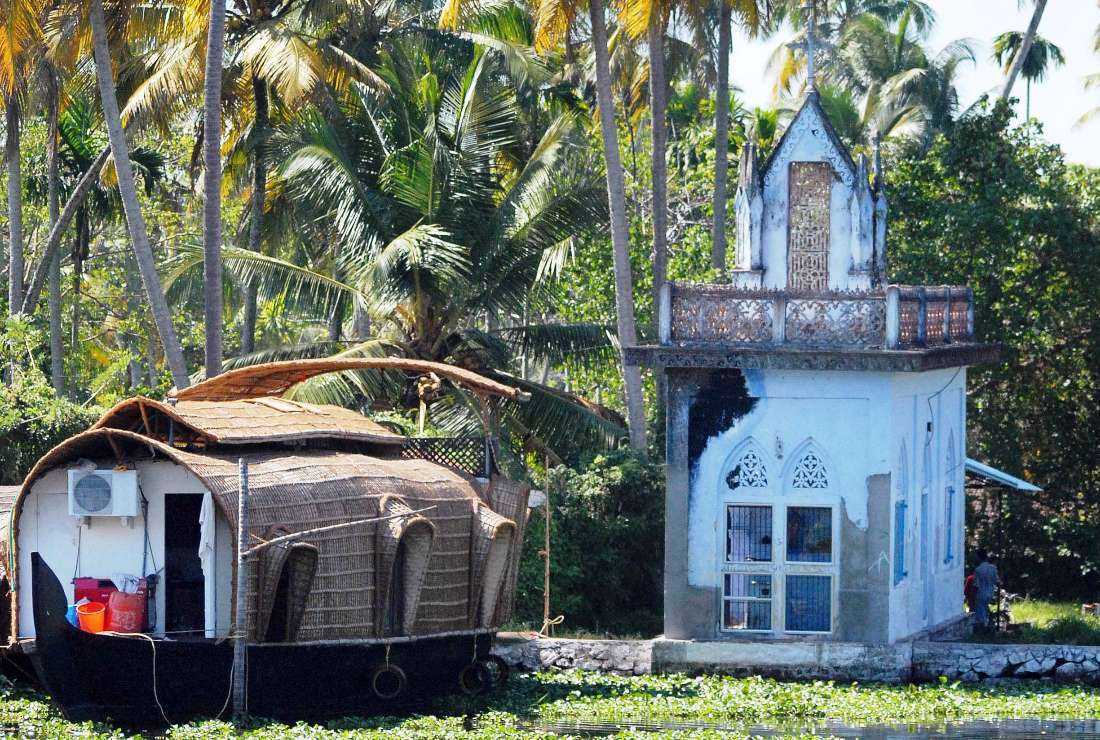It’s not too late for Indian Christians to end caste mentality in the centenary year of Vaikom Satyagraha in Kerala

This photo taken Dec. 29, 2006, shows a houseboat anchored beside a church in the backwaters of Alappuzha, some 150 kilometers north of Thiruvananthapuram, capital of India’s southern state of Kerala. (Photo: AFP)
March 30 this year marked the start of the centenary celebrations of an unusual Satyagraha—a non-violent struggle devised by the Father of the Indian nation Mahatma Gandhi—that forced higher castes to open their temple premises in southern Kerala for the outcaste people, considered untouchables under the caste system.
The 20-month-long struggle that began in 1924 in Vaikom temple town became a landmark in the fight against the Hindu caste system that among others banned public spaces and places of worship for the lower caste.
The struggle found partial success when authorities removed prohibitions on Nov. 25, 1924. It also paved the way for a new thought on human equality in the Indian psyche.
The role of British Christian missioners, and the Western education they initiated in the erstwhile princely state of Travancore and in the Malabar region, although rarely spoken about now, has been identified as the main reason for starting this historic struggle in the sleepy temple village of Vaikom under Kottayam district in Kerala’s central region.
Primarily, Christian missionaries, with British colonial support, reached out to interior villages of central Kerala and thousands of lower caste people accepted Christianity in their attempt to escape the inhuman oppression under a divisive caste system that prevailed in Kerala then.
The Christian missioners, records would show, relentlessly spoke against the caste system, a social stratification sanctioned under Hinduism, and designed to subjugate sections of people to engage them in menial jobs.
The newly converted lower caste Christians’ resistance to caste classifications emboldened their non-Christian brethren to challenge the system for rights to freedom, and access to public species and religious places.
The other reason was British-initiated English education, which helped the emergence of a new class of civilized people in Kerala. Although a minority, they were receptive to the Renaissance ideas of liberty, fraternity and equality.
They belonged to both higher castes and as well lower castes but stood together to fight for the ideals of the Renaissance and audaciously criticized the uncivilized caste system and the religion that supported it.
The spread of English education was the turning point in social change. Modern education, which began early in Kerala with British missioners starting the first school in Kottayam in the 19th century, also meant Kerala leading the caste struggle.
By 1844, the king of Travancore would declare that “those trained in English School would be given preference” in government jobs. For the first time, birth was not taken as the yardstick to get the much-coveted government job then.
However, European colonizers and the missioners, who started a mission of civilization in Asia, found the caste system in the rest of the Indian subcontinent an uphill task to stave off. In most parts of India, the English and European missionaries were forced to stand as mute spectators to the inhuman caste practice, where birth decided a person’s status and job.
Under the retarding caste system, a priest’s son is always a priest, a ruler’s son another ruler, a trader’s son, a trader, and a carpenter’s son follows his father, and a scavenger’s son has to work as a scavenger no matter how educated he is, or what religion he chose to follow.
The scavengers and others doing menial work were outcastes—those outside the caste system. The higher castes would be polluted even if their shadow fell on them, so coming closer was unimaginable. The high caste had the power to punish and even kill the outcastes for violating caste prescriptions. Changing religion or getting educated was not much help.
The untouchability and caste system were so rigid that even after it was outlawed by the Indian constitution in 1950, it continued covertly and overtly. And, it continues in subtle ways, most tragically within even Christian Churches.
Missionaries failed to replicate the Kerala model in the rest of India, probably because of the limited human resources available to work in a geographically huge and culturally diverse land mass in the subcontinent.
But yet, they needed results for their work and sought ways to allow both high castes and lower castes in the same church without offending the social sensibilities of caste discrimination. At some point, we see at least a few missionaries working exclusively among high castes and most of them not speaking against the caste system loudly.
Some churches also accommodated lower castes and higher castes, but in separate wings, allowing caste discrimination. Slowly Christians at least in some places developed separate churches, cemeteries, and celebrations for even Catholics in the same parish area. That was the beginning of a social tragedy.
If the education initiated by missionaries gave the necessary impetus for the Vaikom Satyagraha, we see nothing similar in other parts of India. But tragically, what we would see in several parts of India, and even in Kerala, was the emergence of vivid caste practices within Christian communities.
Even in Kerala, certain groups of Christians take pride in claiming that their ancestors were priestly caste Hindu Brahmins baptized by St. Thomas. Apart from the historical idiocy of it – there were no Brahmins on the Kerala coast in the first century, if at all St. Thomas visited the area — the claim also shows how they continue to carry the caste.
The centenary of the Vaikom Satyagraha is not too late for Indian Christians, at least for Catholics in Kerala, to start a campaign to end the caste mentality—the caste-based talks and dealings—imbibing the ideals of equality, fraternity and liberty for the well-being of their religion.
* The views expressed in this article are those of the author and do not necessarily reflect the official editorial position of UCA News.

